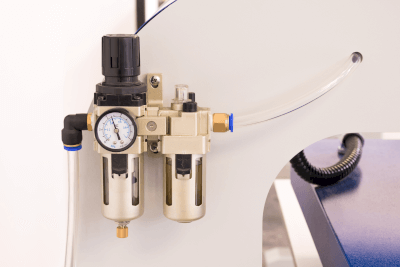What Is an Air Flowmeter?

An air flowmeter is a flowmeter that measures the amount of air flowing through a pipe.
The principle of flowmeter measurement varies, and it can be used to measure a variety of gases and liquids. There are many flowmeter products, and the output method varies greatly depending on the product, such as those with only a sensor that measures flow rate and an electrical output, and those with a display unit.
Due to the difference in the principle of measurement, there are also many non-contact types that do not come into contact with the fluid to be measured.
Uses of Air Flowmeters
Air flow meters are widely used in manufacturing where fluids are used, such as chemical and petroleum plants, automotive, semiconductor, electronics, pharmaceutical, food, resin processing, and welding processes.
The fluids that can be used vary depending on the product. Many air flowmeters are capable of measuring not only air but also other gases, such as nitrogen and argon.
Flowmeters that are installed in a pipe may disrupt the flow. It is important to consider the extent of this effect before making a selection.
Principle of Air Flowmeters
An air flowmeter is a type of flowmeter that measures gas, and there are many principles of measurement. Examples of gas flow rates that can be measured are ultrasonic, differential pressure, thermal, and Kalman vortex.
1. Ultrasonic Flowmeter
This flowmeter utilizes the property of ultrasonic waves to propagate through a material. Ultrasonic waves are received diagonally across the gas in the pipe, and the difference in propagation time between the two ultrasonic waves is converted to a flow rate.
The advantages of ultrasonic flowmeters are that there is no pressure loss and that some types can be detected from outside the piping.
2. Differential Pressure Flowmeter
The principle of differential pressure flowmeters is based on Bernoulli’s theorem. An orifice is installed in the fluid flow path, and the flow rate is measured by detecting the pressure difference before and after the orifice.
The pressure difference is detected using a diaphragm. Advantages include low cost. Disadvantages include the need for a long, straight pipe section upstream and downstream of the flowmeter and a small maximum-minimum flow ratio.
3. Thermal Flowmeter
Thermal flowmeters measure the flow rate by detecting the amount of heat taken away from a heating element by a fluid. Since there are no moving parts, maintenance is not required, and even minute flow rates can be measured. There are also types that can measure temperatures ranging from several hundred degrees Celsius to ultra-low temperatures of -100 degrees Celsius or lower. Direct measurement of gas mass flow rate is possible.
4. Kalman Vortex Flowmeter
When fluid passes through an object, regular vortices are generated. Kalman vortex anemometers measure the flow rate by detecting the number of these vortices with a piezoelectric element or the like. It is susceptible to vibration and acoustic noise and requires a straight pipe section for installation.
5. Surface Flowmeter
In an area flowmeter, a float in a vertical tapered tube interrupts the flow from bottom to top, creating a pressure difference before and after the float. The meter rests at a position where the weight of the float and the force of the pressure difference are in equilibrium, and by reading the position, the flow rate can be measured.
The advantages of this type are its simple structure, low cost, and the fact that it does not require a straight pipe section or power supply. On the other hand, it also has disadvantages, such as large errors in the presence of pulsation and problems with dirt and wear of the float.
6. Coriolis Flowmeter
A Coriolis flowmeter consists of two U-tubes, a vibrating machine, and a force sensor. This flowmeter utilizes the principle of two oscillating U-tubes with fluid flowing through them, which generate forces in opposite directions to each other, i.e., Coriolis force.
Although the measuring principle has the disadvantage of increasing the overall length, it can directly measure the mass flow rate. It is highly accurate and responsive.
How to Select an Air Flowmeter
There are many types of flowmeters, and they are selected based on the object to be measured, the purpose of the measurement, and price.
1. Object of Measurement
The density, viscosity, conductivity, contaminants, corrosiveness, maximum and minimum flow rates, pulsation, temperature, pressure, and allowable pressure drop of the air to be measured are considered.
2. Purpose of Measurement
Once the intended use of the measured results is clarified, the measurement accuracy also becomes clear and the appropriate type of flowmeter can be selected. For example, if the purpose is to monitor or alarm the flow rate, high accuracy is not necessary.
Also, mass flow is often obtained by converting from volume flow, but if accuracy is required, a flowmeter that can directly measure mass flow is needed. Specifically, thermal or Coriolis flowmeters are suitable.